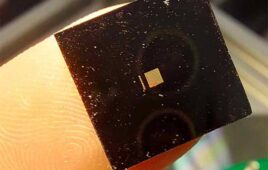
[Image from unsplash.com]
The method uses a femtosecond oscillator that delivers pulses of very low energy at a high repetition rate. This allows for selective and localized alteration of biochemical and biomechanics properties of corneal tissues while changing the tissue’s macroscopic geometry. The new method requires no surgery and has fewer side effects and limitations than traditional vision correction methods.
“We think our study is the first to use this laser output regimen for non-invasive change of corneal curvature or treatment of other clinical problems,” Sinisa Vukelic, one of the researchers, said in a press release.
There is enough power in the new technique to create a low-density plasma within the set focal volume, but there is not enough energy created to damage tissues in the treatment area.
“We’ve seen low-density plasma in multi-photo imaging where it’s been considered an undesired side-effect,” Vukelic said. “We were able to transform this side-effect into a viable treatment for enhancing the mechanical properties of collagenous tissues.”
Low-density plasma induction causes ionization of water molecules in the cornea, according to the researchers. Consequently, the ionization makes a reactive oxygen species that interacts with the collagen fibrils to form chemical bonds or crosslinks. Introducing the crosslinks selectively creates change in the mechanical properties of corneal tissue.
Crosslinking changes the collagen properties in the eye which creates changes in the overall macrostructure of the cornea. The non-invasive method ionizes targeted molecules in the cornea and avoids optical breakdown of corneal tissue. The process is photochemical, which means it does not harm tissue and the changes stay the same.
“If we carefully tailor these changes, we can adjust the corneal curvature and this change the refractive power of the eye,” Vukelic said. “This is a fundamental departure from the mainstream ultrafast laser treatment that is currently applied in both research and clinical settings and relies on the optical breakdown of the target materials and subsequent cavitation bubble formation.”
Eye glasses and contact lenses are temporary and simple solutions to eye issues like nearsightedness. Other solutions like vision correction surgery are invasive and have the potential to have post-surgical complications, including vision loss in rare cases.
“Refractive surgery has been around for many years, and although it is a mature technology, the field has been searching for a viable, less invasive alternative for a long time,” Leejee H. Such, an associate professor of ophthalmology at Columbia University Medical Center, said. “Vukelic’s next-generation modality shows great promise. This could be a major advance in treating a much larger global population and address the myopia pandemic.”
Now the research group is planning to build a clinical prototype and start clinical trials by the end of this year. They also hope to create a way to predict corneal behavior as a function o laser irradiation and how the cornea might deform if a small circle or an ellipse were treated. The researchers suggest that knowing how the cornea will behave is important for personalizing treatment.
“What’s especially exciting is that our technique is not limited to ocular media–it can be used on other collagen-rich tissues,” Vukelic said. “We’ve also been working with Professor Gerard Ateshain’s lab to treat early osteoarthritis, and the preliminary results are very, very encouraging. We think our non-invasive approach has the potential to open avenues to treat or repair collagenous tissue without causing tissue damage.”
The research was published in the journal Nature Photonics and was funded in part by the Wallace H. Coulter Foundation.




